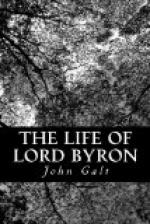The ancients have certainly stolen the best ideas of the moderns; this very thought may be found in the works of that ancient-modern, Waller:
That eagle’s fate and mine are one,
Which on the shaft that made him
die,
Espied a feather of his own
Wherewith he wont to soar on high.
His Lordship disdained to commit any larceny on me; and no doubt the following passage from The Giaour is perfectly original:
It is as if the dead could feel
The icy worm around them steal;
And shudder as the reptiles creep
To revel o’er their rotting sleep,
Without the power to scare away
The cold consumers of their clay.
I do not claim any paternity in these lines: but not the most judicious action of all my youth was to publish certain dramatic sketches, and his Lordship had the printed book in his possession long before The Giaour was published, and may have read the following passage in a dream, which was intended to be very hideous:
Then did I hear around
The churme and chirruping of busy reptiles
At hideous banquet on the royal dead:—
Full soon methought the loathsome epicures
Came thick on me, and underneath my shroud
I felt the many-foot and beetle creep,
And on my breast the cold worm coil and crawl.
However, I have said quite enough on this subject, both as respects myself and his seeming plagiarisms, which might be multiplied to legions. Such occasional accidental imitations are not things of much importance. All poets, and authors in general, avail themselves of their reading and knowledge to enhance the interest of their works. It can only be considered as one of Lord Byron’s spurts of spleen, that he felt so much about a “coincidence,” which ought not to have disturbed him; but it may be thought by the notice taken of it, that it disturbs myself more than it really does; and that it would have been enough to have merely said—Perhaps, when some friend is hereafter doing as indulgently for me, the same kind of task that I have undertaken for Byron, there may be found among my memoranda notes as little flattering to his Lordship, as those in his concerning me. I hope, however, that friend will have more respect for my memory than to imitate the taste of Mr Moore.
CHAPTER XXIX
Lord Byron in 1813—The Lady’s Tragedy—Miss
Milbanke—Growing
Uneasiness of Lord Byron’s Mind—The
Friar’s Ghost—The Marriage—A
Member of the Drury Lane Committee—Embarrassed
Affairs—The
Separation
The year 1813 was perhaps the period of all Lord Byron’s life in which he was seen to most advantage. The fame of Childe Harold was then in its brightest noon; and in that year he produced The Giaour and The Bride of Abydos—compositions not only of equal power, but even tinted with superior beauties. He was himself soothed by the full enjoyment of his political rank and station; and though his manners and character had not exactly answered to the stern and stately imaginations which had been formed of his dispositions and appearance, still he was acknowledged to be no common man, and his company in consequence was eagerly courted.




